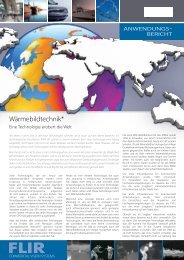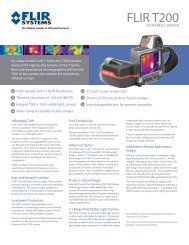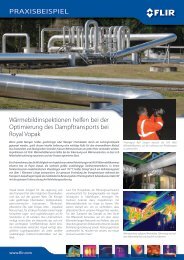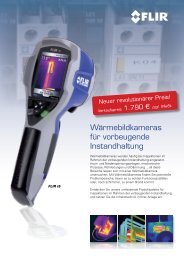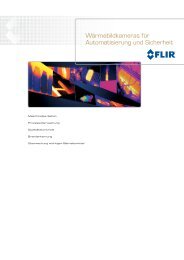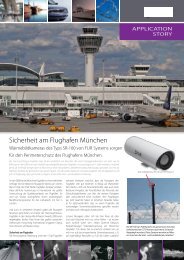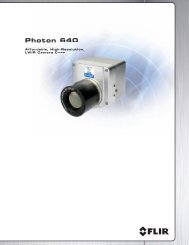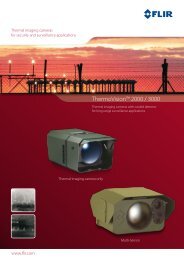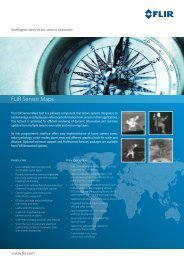Download Application Story - Flir Systems
Download Application Story - Flir Systems
Download Application Story - Flir Systems
You also want an ePaper? Increase the reach of your titles
YUMPU automatically turns print PDFs into web optimized ePapers that Google loves.
application story<br />
FLIR thermal imaging cameras help determine<br />
the functionality of anti-allergy medicine<br />
Ongoing research at Charité Berlin enhanced with<br />
thermal imaging cameras<br />
Thermography using FLIR thermal imaging cameras is one of the most efficient techniques<br />
for the study of skin temperature. It is an accurate, quantifiable, non-contact, non-invasive,<br />
diagnostic technique that allows the examiner to visualize and quantify changes in skin surface<br />
temperature using high performance thermal imaging cameras.<br />
One of the leading medical institutes that use a thermal imaging camera from FLIR is the Allergy<br />
Center of the university hospital Charité Berlin. For several ongoing studies of wheal and flare<br />
reactions in the skin the research team of Professor Marcus Maurer at the Allergie-Centrum-<br />
Charité, the allergy center of Charité - Universitätsmedizin Berlin uses a FLIR thermal imaging<br />
camera to accurately measure the body’s temperature after it is exposed to certain triggers. “It<br />
really is a great tool to objectify the body’s response”, explains assistant physician and clinical trial<br />
investigator Elena Ardelean.<br />
FLIR thermal cameras are the leading<br />
choice in clinical, veterinarian and research<br />
medicine as they have proven to be<br />
highly accurate, reliable and easy to use.<br />
Thermal imaging cameras are a sensitive<br />
diagnostic tool for a multitude of clinical<br />
and experimental situations, ranging from<br />
breast cancer screening to open heart<br />
surgery.<br />
www.flir.com<br />
Thermography is based on the analysis of<br />
skin surface temperatures as a reflection<br />
of normal or abnormal human physiology<br />
using a high performance thermal imaging<br />
cameras. The camera generates images<br />
with thermal data in real time. In a fraction<br />
of a second, a large area of the human body<br />
can be imaged and dynamic responses to<br />
stimuli can be documented quite easily.<br />
A thermography examination shows an abnormal temperature<br />
difference, possibly indicating breast cancer in<br />
the left breast.<br />
These varicose veins very clearly show up on the thermal<br />
image.<br />
Safe and effective<br />
Thirty years of clinical use and more than<br />
8,000 peer-reviewed studies in the medical<br />
literature have established the use of<br />
thermal imaging cameras as a safe and
application story<br />
Elena Ardelean, assistant physician at the Allergie-<br />
Centrum-Charité, the allergy center of Charité -<br />
Universitätsmedizin Berlin.<br />
effective method to examine the human<br />
body. It is completely non-invasive, and as<br />
such it does not require the use of radiation<br />
or other potentially harmful elements.<br />
Medical research has shown thermography<br />
to be a useful tool in research as well as<br />
being helpful in the diagnosis of breast<br />
cancer, nervous system disorders, metabolic<br />
disorders, neck and back problems, pain<br />
syndromes, arthritis, vascular disorders, and<br />
soft tissue injuries among others.<br />
Nobel Prize winners<br />
At the clinical research center of Charité<br />
This thermal image shows a cold urticaria patient’s arm<br />
before a wheal and flare reaction is triggered.<br />
The skin heats up and the cold spot disappears.<br />
Berlin a thermal imaging camera from FLIR<br />
<strong>Systems</strong> is used in a number of different<br />
studies. The scientists and physicians of<br />
Charité are engaged in state-of-the-art<br />
research, patient care and education. It<br />
extends over four campuses with more<br />
than 100 clinics and institutes bundled<br />
under 17 Charité Centers. The Charité<br />
also has an international reputation for<br />
excellence in training. More than half of the<br />
German Nobel Prize winners in medicine<br />
and physiology come from the Charité.<br />
Studying wheal and flare reactions<br />
The Allergie-Centrum-Charité uses a<br />
thermal imaging camera for studies of<br />
medical conditions that include wheal<br />
and flare reactions within the symptoms.<br />
“There are different allergic and nonallergic<br />
reactions that cause the release of<br />
histamine stored in mast cells in the skin in<br />
certain body locations”, explains Ardelean.<br />
“Histamine is an important mast cell<br />
mediator involved in immune responses.<br />
As part of an immune response to allergens,<br />
histamine is released from its stores in mast<br />
cells. Histamine triggers the inflammatory<br />
response, which means that it increases the<br />
permeability of the capillaries followed by<br />
A cooling element that has been cooled down to 4°C is<br />
applied to the skin.<br />
Soon it becomes a hot spot due to the wheal and flare<br />
reaction<br />
Flares show up clearly on the thermal image.<br />
tissue edema and itch due to the action on<br />
peripheral sensitive nerves.<br />
“When the mast cells in the skin release<br />
histamine as result of an allergic reaction,<br />
that part of the skin will develop a wheal<br />
and flare reaction”, continues Ardelean. “The<br />
reaction usually occurs in three stages,<br />
beginning with the reddening of a patch<br />
of skin, followed by development of a<br />
flare surrounding the initial mark, as the<br />
histamine causes the blood vessels to<br />
dilate, allowing the blood to flow towards<br />
that area. Finally a wheal – a raised and itchy<br />
The patch of skin where the cooling element was applied<br />
show up as a cold spot.<br />
In this thermal image the wheal and flare reaction clearly<br />
shows up as a hot spot.
Cold urticaria: In this case a cooling element at 4°C is used<br />
to trigger a wheal and flare reaction.<br />
area of skin – forms at the site as fluid leaks<br />
into the skin from affected capillaries. The<br />
itching feeling is caused by the response of<br />
the nerves in the skin to the high levels of<br />
histamine and other mast cell mediators.”<br />
Spontaneous urticaria and mastocytosis<br />
More specifically the thermal imaging<br />
camera is used in studies of chronic<br />
spontaneous urticaria and mastocytosis.<br />
FLIR SC660<br />
Resolution thermal image:<br />
640 x 480 pixels<br />
application story<br />
The color alarm in the thermal image of this man clearly<br />
shows the parts of the head with a temperature higher than<br />
38°C, indicating an elevated body temperature due to fever.<br />
The importance of thermal imaging<br />
According to Ardelean the thermal<br />
imaging camera from FLIR <strong>Systems</strong> plays<br />
an important part in her research. “It really<br />
is a perfect way to accurately measure the<br />
temperature of the wheal and flare reaction<br />
and to monitor the development of the<br />
temperature over time. This really helps to<br />
objectify the body’s reaction, allowing for a<br />
scientific comparison between the results<br />
with and without the antihistamine.”<br />
Easy to use<br />
Ardelean admits that handling the camera<br />
seemed a bit daunting at first. "I was not used<br />
to using this type of equipment and I was<br />
Skin microdialysis: Where the trigger has been applied the<br />
skin is flushed with a buffer solution to capture the mediators<br />
released in the skin.<br />
Fluid samples are collected every 5 minutes for a period of<br />
half an hour and put on ice for future analysis.<br />
This thermal image clearly shows insufficient blood<br />
circulation in the patient’s hand.<br />
worried it would be difficult to handle, but<br />
I must say that both the thermal imaging<br />
camera and the ResearchIR software that<br />
came with it are very easy to use. Even<br />
though this type of equipment was new to<br />
me I was able to learn the basics and start<br />
collecting research data very quickly.”<br />
Another medical condition we conduct<br />
research on is mastocytosis. “That’s a group<br />
of rare disorders caused by the presence of<br />
too many mast cells in a person's body. In<br />
this research we mainly focus on patients<br />
who have mastocytosis of the skin. Due<br />
to the presence of an abundance of mast<br />
cells certain triggers can cause a wheal and<br />
flare reaction that is similar to the urticaria<br />
symptoms.”<br />
From cold spot to hot spot in minutes<br />
Ardelean´s current studies are in cold<br />
urticaria. “In this case we use a cooling<br />
element that has been cooled down to 4°C<br />
to trigger the wheal and flare response”,<br />
continues Ardelean. “In the thermal image<br />
you can see the cold spot left behind by<br />
the cooling element. After the cold<br />
provocation the skin site quickly heats up<br />
and develops a hot spot, allowing us to<br />
accurately measure both the duration and<br />
intensity of the wheal and flare reaction.”<br />
In this research, however, no antihistamine<br />
is administered. “In this case we want to<br />
find out what the chemical reaction is in<br />
the skin, so we flush the skin with neutral<br />
moisture and collect the drainage every<br />
five minutes for about half an hour. We<br />
repeat this procedure with and without<br />
triggering a wheal and flare reaction and<br />
then we determine the mediator in the<br />
collected samples, so we can see if there are<br />
correlations between their concentrations<br />
and the wheal and flare reaction.”<br />
Ardelean found the thermal imaging camera and the<br />
software that came with it very easy to use.<br />
Thermal imaging camera helps us to<br />
understand the disease<br />
“These studies will allow us to better<br />
understand what is actually happening<br />
with these diseases and enable a better<br />
treatment of these diseases in the future.<br />
The thermal imaging camera from FLIR<br />
<strong>Systems</strong> at the Allergie-Centrum-Charité<br />
helps to make that possible”, concludes<br />
Ardelean.<br />
For more information about thermal imaging<br />
cameras or about this application,<br />
please contact:<br />
FLIR Commercial <strong>Systems</strong> B.V.<br />
Charles Petitweg 21<br />
4847 NW Breda - Netherlands<br />
Phone : +31 (0) 765 79 41 94<br />
Fax : +31 (0) 765 79 41 99<br />
e-mail : flir@flir.com<br />
www.flir.com<br />
T820171 {EN_uk}_A




